 |
Tube Tester TV-7/U Hickok Electrical Instruments Co. USA - 1953 |
 |
 Italiano
Italiano |
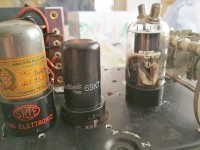 |
English
 Schematic Documentations |
|
|
Click sulle immagini sottostanti per
ingrandirle
|
|||
|
|
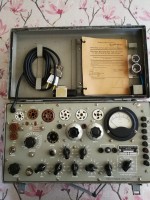 |
|
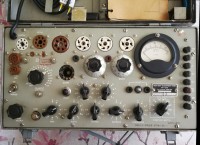 |
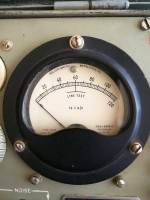 |
 |
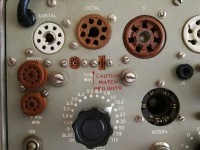 |
 |
|
Rispetto all'I-177 il TV-7 aveva il vantaggio di ospitare sul pannello frontale gli zoccoli delle valvole in quel momento più recenti, le subminiatura, pur mantenendo ancora quelli dei tubi in voga negli anni 30 e 40, come per esempio le valvole tipo 24, 27, 45, 56, 75, 807, le acorn e tutta la serie di tubi americani seguenti tipo 2A3, 6A3, 6V6, 6L6 ecc. Il tutto senza dover essere collegato a unità esterne per implementare i tipi di zoccolature come succedeva al comunque validissimo I-177. L'esemplare di TV7 in mio possesso è un TV7/U costruito nel 1953 con matricola 1029 dalla ditta Hickok Electrical Instruments Co. Cleveland, Ohio, United States. Tale strumento di misura l'avevo acquistato all'inizio degli anni 80' in una fiera dell'elettronica e da più di quarant'anni mi accompagna nella mia lunga avventura nel mondo dei tubi termoionici.Nel corso di tutti questo tempo il TV/7 mi ha permesso di testare centinaia di valvole e a tutt'oggi lo considero uno strumento indispensabile per la riparazione delle vecchie radio a valvole e per la realizzazione di circuiti sperimentali che utilizzano tubi termoionici particolari. Recentemente per esempio ho realizzato e sperimentato con successo un ricevitore VHF a superreazione che utilizza la valvola CV6 (alias E1148 o VT232), un residuato bellico degli anni 40', e il provavalvole mi è stato indispensabile per scegliere il più efficiente di quegli strani tubi bicornuti tra i quattro che giacevano da molti anni inutilizzati nel capace cassetto delle meraviglie del mio tavolo di lavoro. Per testare l'amplificazione delle valvole il TV7/U utilizza il metodo della mutua conduttanza. Il circuito del provavalvole comprende un sistema di test per la linea elettrica a 110 Vac e un alimentatore che fornisce le corrette tensioni ai tubi da analizzare tramite cinque circuiti di prova. Questi cinque circuiti di prova sono: il test dei cortocircuiti, il test del rumore, il test della raddrizzatrice, il test della mutua conduttanza e il test dei tubi a gas. Dopo l'accensione dello strumento, la regolazione della tensione di 110 Vac della linea di alimentazione avviene premendo il pulsante n.1 sulla destra e ruotando il reostato Line Adjust (R126) da 200 Ohm 10W posto in basso a a sinistra fino a centrare l'indice dello strumento sul segno "Line Test". L'applicazione delle tensioni di prova ai piedini del al tubo in esame vengono selezionate tramite nove commutatori rotanti, due potenziometri e i rimanenti sette pulsanti a destra. I dati da impostare sui commutatori Grid, Plate, Screen, Cathode e Suppressor e sui potenziometri Bias e Shunt sono tratti dal libriccino conservato nel coperchio del provavalvole, il Test Data, che contiene i riferimenti per le centinaia di tipi di valvole che il TV-7/U può testare. I risultati del test sono visibili sulla scala graduata dello strumento, un sensibile microamperometro da 200 µA f.s. o dall'eventuale accensione della lampadina spia (E101) in caso di cortocircuiti tra gli elettrodi delle valvole. Le valvole raddrizzatrici utilizzate nell'alimentatore del TV7-U sono due: una 83 e una 5Y3GT. Ia Fuse Lamp è una lampadina da 6.5 Volt 1.02A tipo GE#81 (Miniature Bulb BA15S Base). Il doppio diodo CR101 è un raddrizzatore all'ossido di rame con ingresso a 4,5 VAC e uscita a 3 VDC max 5 mA. L'alimentazione del provavalvole avviene tramite rete a corrente alternata da 105 a 125 Vac, 50 - 1000 Hz. Lo strumento è contenuto in una valigetta metallica dotata di maniglia per il trasporto, le dimensioni sono (L, H, P)44 x 22 x 15.5 cm, e il peso è di 8.164 Kg / 18 lb. © IK3HIA, 2004, 2023 |
|||
 |
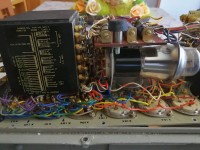 |
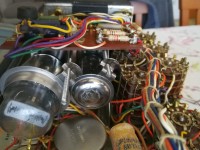 |
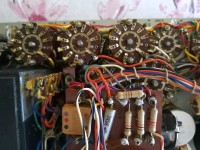 |
 |
 |
 |
 |
 The U.S.A. tube tester mod. TV-7 dates back to the early 50s when in the
various laboratories of the U.S. Army, Navy and Air Force this
instrument gradually replaced its predecessor, the type I-177 built
during the Second World War and now obsolete.
The U.S.A. tube tester mod. TV-7 dates back to the early 50s when in the
various laboratories of the U.S. Army, Navy and Air Force this
instrument gradually replaced its predecessor, the type I-177 built
during the Second World War and now obsolete.Compared to the I-177, the TV-7 had the advantage of housing on the front panel the most recent tube sockets, the subminiature ones, while still maintaining those of the tubes in vogue in the 30s and 40s. such as for example the valves type 24, 27, 45, 56, 75, 807, the acorns and all the series of American tubes following type 2A3, 6A3, 6V6, 6L6 etc. All without having to be connected to external units to implement the types of sockets as happened to the still very valid I-177. The TV7 example in my possession is a TV7/U built in 1953 with serial number 1029 by Hickok Electrical Instruments Co. Cleveland, Ohio, United States. I had purchased this measuring instrument in the early 80s at an electronics fair and it has been with me for more than forty years in my long adventure in the world of thermionic tubes. During all this time the TV/7 has allowed me to test hundreds of tubes and to this day I consider it an indispensable tool for the repair of old tube radios and for the creation of experimental circuits using particular thermionic tubes. For example, I recently built and successfully tested a super-reaction VHF receiver that uses the CV6 valve (alias E1148 or VT232), a war surplus from the 1940s, and the valve tester was essential for me to choose the most efficient of those strange tubes two-cornered among the four that had been lying unused for many years in the capacious wonder drawer of my work table. To test tube amplification the TV7/U uses the mutual conductance method. The valve tester circuit includes a 110 Vac mains test system and a power supply that supplies the correct voltages to the tubes to be tested via five test circuits. These five test circuits are: the short circuit test, the noise test, the rectifier test, the mutual conductance test and the gas tube test. After switching on the instrument, the regulation of the 110 Vac voltage of the power supply line takes place by pressing button n.1 on the right and turning the 200 Ohm 10W Line Adjust rheostat (R126) located at the bottom left until centering the instrument index on the "Line Test" mark. The application of test voltages to the pins of the tube under test are selected via nine rotary switches, two potentiometers and the remaining seven buttons to the right. The data to be set on the Grid, Plate, Screen, Cathode and Suppressor rotary switches and on the Bias and Shunt potentiometers are taken from the little book kept in the lid of the valve tester, the Test Data, which contains references for the hundreds of types of valves that the TV- 7/U can test. The test results are visible on the graduated scale of the instrument, a sensitive 200 µA f.s. or by the eventual switching on of the warning light (E101) in the event of short circuits between the valve electrodes. There are two rectifier tubes used in the TV7-U power supply: one 83 and one 5Y3GT. The Fuse Lamp is a 6.5 Volt 1.02A type GE#81 (Miniature Bulb BA15S Base) bulb. The CR101 dual diode is a copper oxide rectifier with 4.5 VAC input and 3 VDC max 5 mA output. The valve tester is powered by the mains from 105 to 125 Vac, 50 - 1000 Hz. The instrument is contained in a metal case equipped with a carrying handle, the dimensions are (W, H, D) 17.3 x 8.7 x 6.1 inch, and the weight is 18 lb. © IK3HIA, 2004, 2023 |
|||
 |
 |
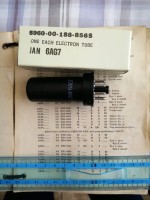 |
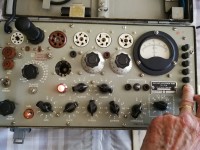 |
| Testing a 0D3W gas valve | Testing a 6AG7 power pentode | ||
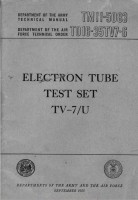 |
 |
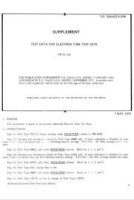 |
 |
| Operating & maintenance manual | TV-7/U Test data | Testa data supplement |
Article published on CQ Elettronica 05/2000 by IK3HIA (in Italian) |
|
Torna a inizio pagina
|
|||